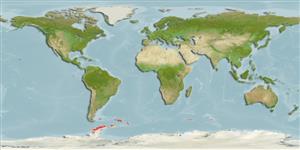Preferred temperature (Réf.
123201): -1.3 - 0.7, mean -0.6 °C (based on 36 cells).
Phylogenetic diversity index (Réf.
82804): PD
50 = 0.5312 [Uniqueness, from 0.5 = low to 2.0 = high].
Bayesian length-weight: a=0.00407 (0.00344 - 0.00482), b=3.24 (3.19 - 3.29), in cm total length, based on LWR estimates for this species (Ref.
93245).
Niveau trophique (Réf.
69278): 3.3 ±0.2 se; based on diet studies.
Résilience (Réf.
120179): Faible, temps minimum de doublement de population : 4,5 à 14 années (Fec=21,699; tm=10).
Fishing Vulnerability (Ref.
59153): Moderate vulnerability (42 of 100).
🛈
Climate Vulnerability (Ref.
125649): Moderate to high vulnerability (46 of 100).
🛈
Nutrients (Ref.
124155): Calcium = 19.7 [11.5, 46.6] mg/100g; Iron = 0.384 [0.181, 0.754] mg/100g; Protein = 17.7 [15.5, 19.6] %; Omega3 = 0.329 [0.180, 0.572] g/100g; Selenium = 16.6 [7.0, 41.1] μg/100g; VitaminA = 12.4 [2.7, 59.6] μg/100g; Zinc = 0.497 [0.332, 0.747] mg/100g (wet weight); based on
nutrient studies. 